Stephen Weinstock's Blog
September 29, 2025
2025 Posts
This year has seen both The Qaraq and The Qaraq and the Maya Factor launch back into the world. Books One and Two of 1001, The Reincarnation Chronicles contain much to discuss. I’m delighted to share my latest thoughts.
Here you’ll find articles from the 2025 Blogosphere of Qaraq Books!
Navigate, enjoy, and read!
The post 2025 Posts appeared first on Qaraq Books.
The Qaraq and the Maya Factor Launch!
I’m over the moon (and maybe one or two past lives beyond it) to announce the launch of Book 2 of The Reincarnation Chronicles: The Qaraq and the Maya Factor.
When I first outlined this series, I knew each book would center on a theme—but I had no clue what Book Two’s theme would be. Then, just days before writing it, inspiration whacked me upside the head (thank you, cosmic scheduler).
I realized I spend way too much time wrestling with trivial daily nonsense—lost keys, endless emails, socks that definitely disappear into another dimension. What if my beloved band of soul-friends, the qaraq, had to deal with the same distractions… only on a cosmic scale?
Thus, Book Two was born.
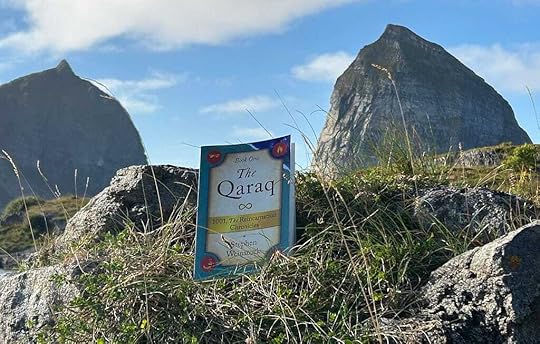
“The more you read this incredible book, the more it blurs the lines between the stories, mythology, science and your own life. It is as if you start to feel yourself part of this epic journey.“
What to Expect in The Qaraq and the Maya FactorIf you’ve read Book One, The Qaraq, you know the setup: a group of intertwined souls discover they’ve lived countless lives together, recalling their past life stories in a 1001 Nights-style weave of history, fantasy, and mischief.
But in Book Two, something goes terribly wrong. Their extraordinary gift of memory is… slipping away. Enter the Maya Factor—a force that traps them in illusions, banality, and distraction. Think Netflix binges, laundry piles, estranged exes who just won’t quit.
Yes, our heroine, Sahara Fleming, passionate Arabic scholar and the Scheherazade of the series, faces a complication: her estranged husband, Amar Rash, won’t stop trying to win her back. Their chemistry is undeniable, but the qaraq’s past-life stories hint that there’s something darker beneath their romance.
As the group struggles with regaining their lost memory, they uncover eerie connections: ancient tombs, an alien performing arts school, a seventeenth-century coven.
Are they unraveling the grand design that has shaped them for centuries? Or are they just spinning in yet another illusion?
Will the qaraq fight through Maya’s fog to remember who they truly are? Or will they remain stuck in the illusion, unable to see past the trivia of daily life?
Start Your Journey HereTo celebrate the launch (and this month only!), both Book One (The Qaraq) and Book Two (The Qaraq and the Maya Factor) are just $0.99 each.
 Get The Qaraq here.
Get The Qaraq here. Get The Qaraq and the Maya Factor here.
Get The Qaraq and the Maya Factor here.
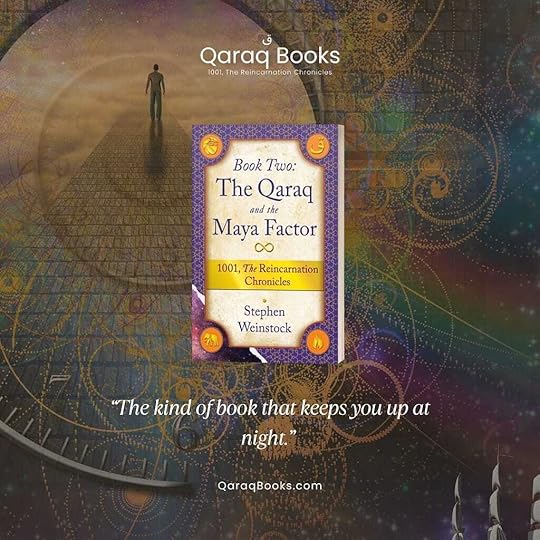 What Readers Are Saying
What Readers Are Saying“The sheer scope of the author’s imagination is exciting; the infinite, often magical detail that adorns each story compels close reading.”
“I have never seen characters live past lives as plants, animals, or mermaids and mermen. This is fiction at its most inventive.”
“In this volume, the characters have lived in many forms, including a lovesick mermaid, frolicking dogs, and a horny glacier.”
“Fantastical imaginings of other worlds is Mr. Weinstock’s signature motif—I look forward to every lyric twist and comic turn.”
Ready to Step Into Maya?Unravel the past. Face the truth. Escape the illusion.
The qaraq’s next chapter awaits you.
 Buy Now on Amazon
Buy Now on AmazonThe post The Qaraq and the Maya Factor Launch! appeared first on Qaraq Books.
September 4, 2025
When Were Dogs First Domesticated? Ask The Qaraq and the Maya Factor
Book Two of 1001, The Reincarnation Chronicles launches 10/01 2025, and with it comes 77 new past life stories.
One of my faves is the story of the first two dogs to be tamed by cave people. Sahara and Amar, the troubled romantic leads of their soul group, recall the love story of these two dogs, their prehistoric reincarnations. Sahara and Amar are separated, but their passion heats up again with these tales. Their friends and neighbors, the souls they have interacted with lifetime after lifetime, their qaraq, are rooting for these two old dogs to get back together.
The First PetsPrehistoric humans domesticated dogs starting around 14,000 BC. That’s the theory, but given how much farther back in time we have found evidence of hominid species, I wonder if tails wagged much earlier than that. But I followed my research and set my cavedog story well after the stories about the Borzi clan that appear in The Qaraq. Book Two, The Qaraq and the Maya Factor, continues the Borzi tales, which are much darker than the bittersweet cavedog legends.
As a sneak peek into Book Two before it launches on 10/01, enjoy a sneak peek into the love story of the first two domesticated dogs.
The Tale of Saaaar and Argmhm, the First CavedogsI was in an inverse fight for territory with that other dog. I wanted him further into my territory, but he wanted me further into his. He sat on that hill for hours, waiting for me to come up there. I knew there were packs of two-leggers there. There was no way I’d trot my behind up to him. Eventually he came down to me, and I led him into the wood.
The first time we saw each other it was like no other dog or wolf had ever existed. He bounded right down his hill, straight for me. Instinctively, I backed into the wood, but did not bare my teeth. He had a strange gentleness I had never experienced in any woodland beast. I called him Argmhm — that was the sound he brought out of me. Argmhm mounted me. My senses opened, my hide tingled, as Argmhm covered me with his warm, furry body. But then I felt trapped, unable to move. My pack was nowhere near. I panicked, freed myself, and ran away, deep into the wood.
After that, Argmhm would appear on his hill, I would nip in and out of the forest edge, and then he’d come after me, further each time. Or he mounted me by the swamp, and as my heat rose he jumped off and made me follow him back to the hill. We wanted each other badly, but neither of us accepted the other’s territory. Eventually we found a secluded hollow halfway between our lairs. He mounted me fiercely, time and again, making up for our stubbornly wasted foreplay.

I fell out of heat just as Argmhm came no more, as if he knew the change was upon me. I was curious where he had gone, and I was lonesome. I braved the edge of the wood and saw him once more atop his hill. Each time he saw me lurking he lowered his head and walked away. He would return several times and repeat this action. Later, Argmhm came down the hill toward me and then retreated back up out of sight. He made wondrously soft sounds that vibrated my heart. I have heard dogs howl, I have heard them growl, but never such mournful, alluring cries.
Argmhm wanted me to follow him home. Would he defend me against the two-leggers up the hill? How had he survived? I had to follow him eventually — but how? Unlike these ridiculous cats with their oversized fangs who prowl under the moon, two-leggers sleep at night. A dog will sleep anytime, day or night, the sensible thing. I would find Argmhm’s lair under cover of darkness.
One late afternoon I teasingly pretended I was ready to follow him. I stalled, continued my game into twilight, and then darted into the wood. He waited a while, then returned home, leaving a fresh scent. Darkness fell and I tracked Argmhm’s magnificent aroma up the hill into an area with cliffs and ledges. Carved into the cliff walls were caves from which eerie lights glowed. My fur trembled: the two-leggers slept here. How could Argmhm’s tracks lead this way?
Gathering my courage, I peeked into a few caves and was surprised by the sleeping bodies on the floors, the silence, the peacefulness. I gained confidence, continued my curious searching, and after many caves discovered the end of Argmhm’s trail.
There he was, curled up in a ball at the foot of an animal fur, under which slept two small two-leggers, a male and female child. The smell of freshly roasted meat was everywhere, setting my nostrils aflame with hunger. A sparking circle of fire and smoke crackled at the cave’s center. I wanted to howl for joy at seeing my mate, bark with desire for a piece of meat, growl at the children for trapping Argmhm. But I dared not. How I wanted to curl up next to him!

It was too strange. A dog lying with two-leggers! Argmhm was not captive or endangered. He chose to make his pack with two-leggers. Disturbed, I dashed back down into the wood.
The next days were tortuous. On the one hand, Argmhm was no longer a dog to me, but a non-creature against everything I knew to be natural. On the other hand, I felt new urges in my body that required his attention, that demanded the quiet protection he found with the two-leggers.
The next time I saw Argmhm he recognized my dilemma. He explained his life with the two-leggers with his soft language of sounds. He too had been born in the wood. But the two-leggers had rescued him from starvation. Intensely curious, the children had begged their clan to bring him home to the cave. They gave him warmth and playfulness and … love. Whispered, this last idea was unfamiliar. But my body understood the lure of the children, the welcome of family.
I was bearing Argmhm’s pups.

Argmhm was wild with fervor. I had to come into the cave now. We would be the first! I thought he was saying it was our first litter. He clarified that he was the first dog to live with two-leggers (I could not argue). No other creature had entered this world, not even gentle mammoths (too large) or wily cats (too independent). We would have the first litter raised with cave dwellers.
Argmhm’s words had a prophetic power over me, for though I could not come into the sight of two-leggers yet, I soon had need of them. Because of my disturbed emotions my body became sick and unpredictable. My pack growled at me with worry, and smelled Argmhm on me. I crept from my lair to Argmhm’s hill too many times for my health. My pups were in danger.
Oh no! More to ComeWill Argmhm succeed in bringing Saaaar into his humans’ cave? Will their pups survive? Will the love story bring Sahara and Amar back together? Or will the past life romance contain as much ambivalence and tension as the present day relationship?
Find out in The Qaraq and the Maya Factor, coming this Fall. The fantasy novel also follows the qaraq as they lose their power to recall past lives and stop learning how they have interacted over their karmic history. The qaraq has to discover what is blocking them, why this veil has many layers, and how to overcome it.
What’s the Maya Factor?Want to know more about what the Maya Factor is? And how it devastates the qaraq? Join The Maqaraqan, the newsletter of The Reincarnation Chronicles, and receive a free gift, the Maya Challenge. It will tell you how trapped in everyday illusions you are, or how connected you are to higher awareness. It’s fun, gorgeous, and a little enlightening….
If you’d like to start out with The Qaraq, the first book in The Reincarnation Chronicles, you can get it here for only $0.99. Read all about how Sahara finds her qaraq unexpectedly in the suburbs of New Jersey. Holy Whole Foods! Get it before the 1001 series reincarnates as Book Two.
If you liked this post, learn more about the series with The Maqaraqan (see footer).
The post When Were Dogs First Domesticated? Ask The Qaraq and the Maya Factor appeared first on Qaraq Books.
July 17, 2025
Are You a Mystic Nerd?
All authors know they should imagine their Ideal Reader.
It sounds simple enough. You picture a certain age group, maybe a gender, a profession, a lifestyle. If you write cozy mysteries about a quilting sleuth, maybe your Ideal Reader is a Crazy Quilt genius. If you write romance, tradition points you to middle-aged women. It can all be very neat and tidy.
Or not.
The Three Guinea PigsMy fantasy series 1001, The Reincarnation Chronicles has wonderful readers, but they don’t tick off neat demographic boxes. One of my loyal readers doesn’t read fantasy. At all. Ever. He’s a transplanted Southern musician in his seventies. Another fan is a D&D devotee — a college-aged, non-binary artist. Then there’s the middle-aged Californian woman who writes in the margins of Dostoevsky and underlines Chomsky. They’re not the same age. Not the same gender, background, or profession.
And yet they all love this series.
I struggled to find the thread that united them. What kind of reader was I writing for? Then, I let the question go — and let creativity take over.
Birth of the Mystic NerdThis is a reincarnation epic with layered storytelling, multiple Worlds, tangled identities and shifting stylistic points of view. It’s anchored by Sahara Fleming, the present-day incarnation of Sharzad — yes, the historical model for Scheherazade. Like many in her soul group (called the qaraq), Sahara doesn’t actually believe in reincarnation. Until the memories start to flood in. Chapter by chapter. Lifetime by lifetime.

There’s complexity: eleven hidden structures in every chapter. There’s absurdity: titles like “The Tale of the Love Spat Between Two Atomic Particles” or “The Tale of Saaaarm and Argmhm, the First Cavedogs.” And there’s recurring mystery: a silver, oval-shaped object that morphs from ancient dagger to elephant talisman to subversive copy of The Thousand and One Nights — each object unlocking some deeper layer of memory.
You’ve got to be a little bit of a Nerd — capital N — to hang in with the repetition, the jumps between realities, the sheer scope. And since there are 1001 past life stories, you probably have a touch of the Mystic, too.
Thus was born my Ideal Reader: the Mystic Nerd.
Back to the Guniea PigsBack to my three devoted qaraqi guinea pigs. Are they spiritual? Not especially. They don’t do Tarot spreads or keep crystals in their nightstands. Like I do. But they love an oddball enigma, a beautiful mind-bender, a story that doesn’t play by the usual rules. That’s Mystic enough for me.
They’re also, every one of them, hardcore Nerds. They treasure obscure facts and love sharing them. They chase meaning through the tangles of ambiguity. They overthink until the cows come home. They love puzzles and obscure indie artists and rabbit holes of forgotten knowledge. They light up at the idea that The Reincarnation Chronicles jumps from World to World — one moment in a laundromat in a parallel universe, the next in an alien school of performing arts. And if I handed them a secret manual decoding all eleven hidden structures per chapter, they’d read it for fun. And annotate.
So, What Is a Mystic Nerd?Someone who finds joy in arcane, curious, or wildly specific information — whether or not it leads to cosmic truth. Someone who dogears pages in The Qaraq so they can keep up with a time jump back to a World visited twelve chapters ago. Someone who underlines phrases in The Qaraq and the Maya Factor, tracking how Sahara and her soul group lose touch with their past lives — because the present becomes too cluttered with the ordinary, the car repairs, the spilled lattes. That’s the Maya Factor: banal reality becoming so loud that it drowns out the echoes of reincarnation.

Some readers are most drawn to these present-day dramas of Sahara and the other qaraqis. Others prefer the wildly imaginative past lives and lose themselves (happily) in the cosmic climax of The Tale of the Nine Thoughts During the Endless Orgasm. Some readers live for the rules and hidden architectures that reveal themselves only after hundreds of pages.
The Mystic Nerd embraces them all.
Sound Familiar? Welcome to the Qaraq.If that sounds like you — if you’ve ever been accused of thinking too much or caring too deeply (about a footnote) — you might just be a Mystic Nerd.
And if so, I think we’re going to get along just fine.
Ready to begin your journey?
Start with The Qaraq, the first volume of The Reincarnation Chronicles. Or if you’re already a Mystic Nerd, go for The Qaraq and the Maya Factor, Book Two, launching 10/01/25.
Past lives, hidden structures, cosmic puzzles — and the daily mess that makes us forget it all.
And become a Mystic Nerd by receiving The Maqaraqan, my newsletter and free gifts (see Footer below).
The post Are You a Mystic Nerd? appeared first on Qaraq Books.
June 24, 2025
Review: S.A. Chakraborty’s Daevabad Trilogy — A Fantasy Rooted in Ancient Power
The second book in my 1001 series, The Qaraq and the Maya Factor, casually alludes to a major Hindu concept, Maya. The concept is defined as Illusion, the power by which the universe becomes manifest, the illusion or appearance of the physical world. The illusion that our physical world is ‘reality’ prevents us from perceiving a higher awareness, of the infinite cosmos or the interconnectedness of all things.
In The Qaraq and the Maya Factor, the illusion is more banal, the distractions we face with our daily tasks and obsessions, so steeped in the physical world. But Maya prevents the qaraq, a group of interconnected souls who have the power to recall their past lives in their present existence, from seeing their incarnations. They battle this blockage and learn how Maya affects – and protects – us on many levels.
Why I’m Drawn to Indian Culture and SpiritualityTo write a series based on reincarnation as an assumed reality has me rubbing elbows with Hindu sages, teachers, and believers. But I love Indian culture as well, its food, its music, its films, its dance. Hearing Anoushka Shankar at New York’s Town Hall the other month reminded me that I have adored this culture from a very young age.
Backpacking in Europe after high school, I was wandering around Hyde Park in London one summer afternoon and came across an interesting building. A woman approached me and offered me an extra ticket to the concert inside. I had no idea the building was the Royal Albert Hall and that the concert artist was Ravi Shankar. But I had listened to his music for years and was thrilled at my luck to hear him live for the first time. Many decades later, there I was at Ravi Shankar’s daughter’s concert, an incredible mix of classical and contemporary style.
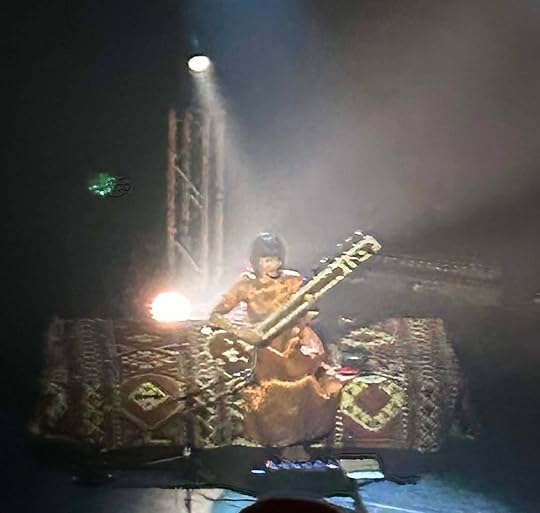 Discovering the Daevabad Trilogy
Discovering the Daevabad TrilogyWhen I learned of Shannon Chakraborty’s fantasy series, the Daevabad Trilogy, set in a mythical world that mixed Hindu, Muslim, and Zoroastrian references with modern language, I was easily attracted to it.
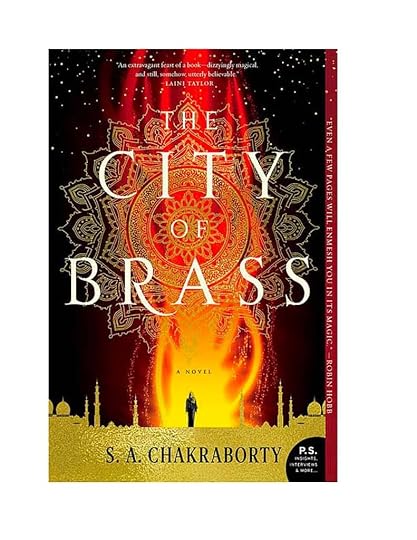
It’s a trilogy (that suggests more to come) of three very big books. There are lots of names of characters and places, loads of detail of food and clothing and geography, but the prose flows like the watery entities that inhabit the book. It satisfies a reader’s need for a complex epic and a page-turner, simultaneously.
My series moves around The Thousand and One Nights, and although I feel a kindred spirit with the cultural land of Chakraborty’s work, there is little specific reference to the Nights. The most common bond is that the population of the book is made up of:
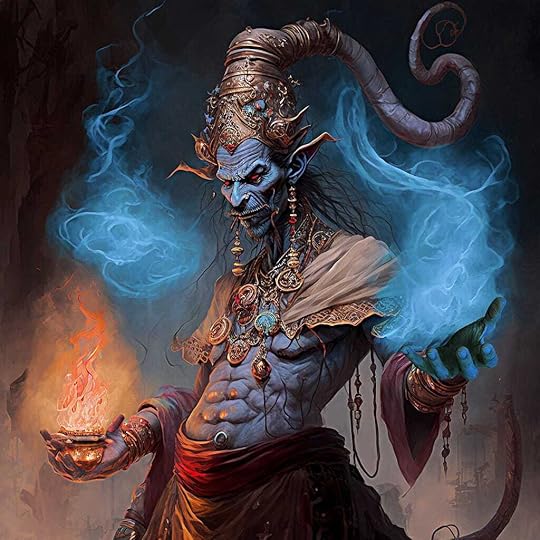
Djinn,
Ifrit,
Marid,
and other preternatural beings that crop up in the Nights’ tales. But when a ‘genie’ appears in the Nights, it is always in service of a plot point, giving the being as much character as needed for the situation. But Chakraborty gives us an encyclopedic taxonomy of each race, including a political and historical perspective on their interrelationships. In fact, I’d say one of the main actions of the series is the uncovering of mysteries and hidden truths in the history of the races in this world.
Characters That Command the PageBut it is the individual representatives of these races that is the greatest delight of the Trilogy. The arc of the first book takes us from the main character Nahri’s roots in the poorest neighborhoods in Cairo to the royal quarter of the most powerful city in the supernatural world, the City of Brass (the title of the first book).
Because of her roots as a survivor and street thief, Nahri has a mouth on her; her colloquial speech and attitude help bridge our world with that of non-humans. Her journey toward discovery of her true nature and power is the last thing in the world she wants, so she struggles mightily against everything happening to her.
And the Number One thing happening to her is that she requires the protection of Dara, a monstrous form whom Nahri has awakened from a much needed sleep away from the world. They need each other, but despise each other’s very being.
One of the most intelligent navigations Chakraborty makes is that the long game of the romantic arc between Nahri and Dara seems unlikely and dangerous. We feel just as sure they shouldn’t be together as they should. As the books continue, their bond grows deeper and deeper, but at the same time becomes more ruinous. There is nothing inevitable or expected about this romantic relationship.
Nahri’s relationship with Ali is more typically rom-dram, with their clashing races and backgrounds, despite their similar passions and intentions.
Again, the romance is long and slow and never obvious; the reader could be happy with a sibling-like interaction developing between them. Yet they have wonderful edgy banter and we root for them as a couple, given that their society is totally against it. As is Dara: the love triangle that heats up between the three of them is the most expected development among them.
 Power, Vulnerability, and the Stakes of Emotion
Power, Vulnerability, and the Stakes of EmotionI’d say the biggest achievement in the creation of these characters is the depiction of their power. Military, magical, herbal, societal, revolutionary – each character has at least one tremendous physical power and one searing emotional power. Everyone is a force to be reckoned with.
There is plenty of time to develop their three-dimensional attributes, but I found myself looking at a softer side, or a more complex angle to a personality, or a back story that justifies some type of behavior – all this nuance made me reassess when a character was going to wield their power. Ali’s father, the king, shows much vulnerability, but it just relaxes me as to when he will strike next. It’s an epic of attacks and feints, as in the many weapon fights during its pages.
Worldbuilding That Engages Every SenseChakraborty is equally adept at depicting the masculine, feminine, and mixed aspects of her characters and their world, which is an extraordinary accomplishment.
But I believe it goes hand in hand with her ability to paint the environments so richly. We always learn about several food items when a tray is brought in. Any entrance of a character is accompanied by what he or she is wearing that morning. Architecture, ecology, pharmacology, weaponry, they all contribute to the details of the sights, sounds, smells, and tastes in this world.
As an author, I use description minimally, perhaps because I often skip ahead when I hit a lengthy descriptive passage in a book. I did that often in Chakraborty’s writing, but I don’t criticize her for it; it’s my problem. I will say that I did it because I was anxious for the next beat in the tense action or entertaining character interaction.
Entering Daevabad: A Suspenseful TransformationThere is a wonderful suspense leading up to the entry into Daevabad, the City of Brass. The action pieces itself out brick by brick to give us enough information to be prepared for what’s coming. But like Nahri, we aren’t sure if the city is real, if we’ll ever arrive safely, or who Nahri actually is in this world until we’re inside the walls of brass.
It’s as if we, as human readers, who wouldn’t be capable of seeing this world invisible to the human race, must undergo enough historical and emotional information before we are allowed to enter. Or before we can believe what we are entering is real.
It’s a solid journey; I almost miss the mystery of its existence once we arrive and get entangled in the politics and family squabbles of the city. But there are plenty of other mysteries remaining.
Comparing Our Worlds: Elements and KarmaOne of my favorite connections to Hindu philosophy, and other cultures as well, is that Chakraborty’s creatures inhabit powers they derive from the Elements. Like igniting fire in your hand, or drawing powerful strands of water toward you. But the elements show up with geo-political importance everywhere. And in descriptions of landscape, environment, and mood, all within a scene or a character.
In my series, The Reincarnation Chronicles, the karma of past lives inhabits everything, from what the characters remember to how they interact in the present. It is all so complex and intriguing, but I’m jealous of Chakraborty taking such a basic concept as the Elements and spinning it out into such endless variations. Beautifully done.
 Balancing Multiple Storytelling Modes
Balancing Multiple Storytelling ModesWriting an extended fantasy series, I work at something else, a balance of a number of components. Dramatic action that moves the story forward. Engaging dialogue interactions between characters. Moments of interiority for the characters working out their issues. World-building sections that sink into the magic and wonder of fantastical places and creatures and concepts.
In The Reincarnation Chronicles, dramatic action and dialogue tend to happen in the present day scenes, while interiority and world-building tend to happen in the past-life stories. But that’s not a hard and fast rule, sometimes it happens in the reverse order.
In the Daevabad Trilogy, Chakraborty makes these happen in every chapter. Some may have different ratios of the elements, but actions always drive forward, characters chat wittily, magical information appears, and someone assesses what’s going on inside them.
The other very impressive technique I admired was a parsed-out exposition. Hundreds of pages into a book, we’ll get a back story about some vital piece of information. It appears when it needs to appear, when a character needs to know it, when the reader needs to know it.
I love this: working on multiple books where I must remind the reader about a story that was recalled in a previous book, I try to be incredibly frugal with how much I remind, and how the information gets out in the action. I usually err on the side of frugality, with my editor telling me I need to provide more back story here and there. But with Chakraborty, I was often dazzled by when she brought up and exposed some vital knowledge. Over the course of two thousand pages!
Why I Love Cultural Fantasy (and Chakraborty)So I adored these books, just as I adore much fiction based on cultural milieu. And especially Indian culture. Or ancient, spiritual cultures.
Last weekend, I attended a workshop about an alternative, radical method of interpreting the Tarot. Lindsay Mack’s ideas are liberating and refreshing. But the workshop was held at The Art of Living, an ayurvedic yoga retreat in the Blue Ridge Mountains. It follows the teachings of a Hindu yogi. It serves vegetarian Indian and Middle Eastern food. And its setting is in those magnificent mountains. Yes, I like to chase complex, delicious cultural experiences.
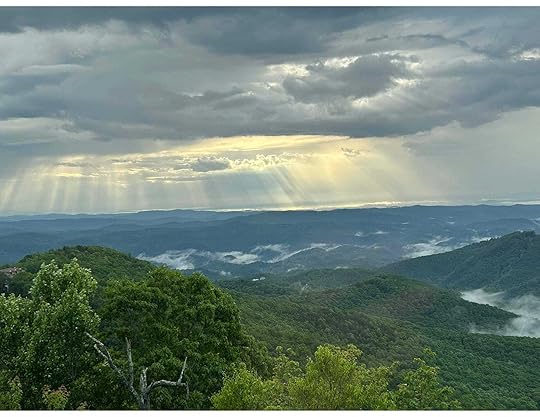 Final Thoughts: Read the Daevabad Trilogy
Final Thoughts: Read the Daevabad TrilogyThe Daevabad Trilogy includes:
The City of Brass The Kingdom of CopperThe Empire of Gold…and the companion collection: The River of Silver
by S.A. Chakraborty
If you’re a lover of deep worldbuilding, philosophical undercurrents, layered characters, and fantasy rooted in culture—these books will delight you.
For exclusive posts on cosmos and culture, book news, and free offers, join The Maqaraqan. (SEE FOOTER)
The post Review: S.A. Chakraborty’s Daevabad Trilogy — A Fantasy Rooted in Ancient Power appeared first on Qaraq Books.
March 24, 2025
OTTAWA FANTASY
In January 2025 I braved the frigid north to attend a writing retreat north of Ottawa, Canada. Brrr! Despite the 1 degree weather (Fahrenheit, Canadian friends, more like a hundred below for you), it was a warm, cozy experience.
If you’d like to know more about how great the retreat and writer support was, from coaches Kevin Johns and Kimberley Grabas, subscribe to my newsletter and request the January 2025 email.
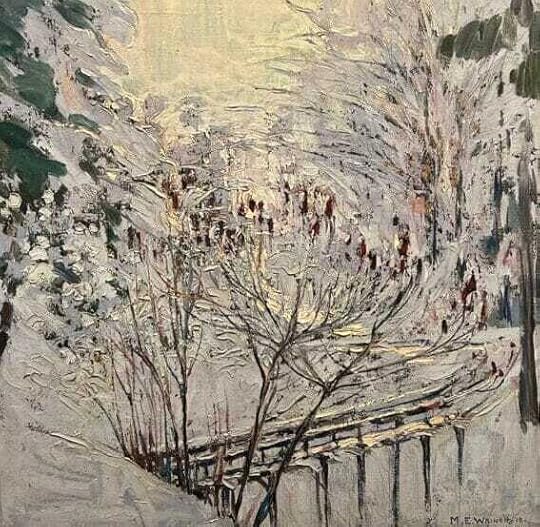
That email describes the great boost I got at the retreat itself, but in the month afterward, I received another boon.
Yes, a boon as in the Hero’s Journey, because it clarified an issue I’ve been grappling for years. I even blogged about it early in my publishing history, as a guest on The Artist Unleashed. As far back as 2014, baby!
The JourneyAt that time I bemoaned that I had not minded young author advice to pick a genre, research it, and create and behave within its boundaries.
Instead, I was all excited about creating some new hybrid form. If reincarnation defined my subject matter, then call it Karma Lit. But if my series was defined by its concept – a soul group recalling past life stories – then those stories are at times historical fiction, science-fiction, fantasy, romance, and modernist literature. That is, a cauldron of a hybrid wrapped in an experimental form posing as an enigma.
The Grail Quest that I set out on was to market this odd duck to an odder, multiple niche group of paté lovers. Some readers would flock to the reincarnation content; others would be intrigued by the 1001 Nights milieu. Still others would sojourn through the series, happy to encounter historical fiction pieces throughout.
I was a proud experimentalist trying to find a commercial audience, but the Grail was elusive, as always.

I was content with my Quest for the Odder Duck for many years, basically content with creating the books and staying in denial about marketing them.
I hunkered down in an identity as a hybrid speculative novelist, even though Amazon made me claim an existing genre like Contemporary Fantasy. And I ‘stooped’ to telling folks my work was a fantasy epic just to save time.
Very little Sword and Sorcery going on, but I said Fantasy nonetheless. Easier that way.
Back to OttawaBack to post-Ottawa days and my boon after this long journey. It was a delight to be among like-minded writers working hard at their craft. When I write ‘like-minded,’ I don’t mean we were writing in the same genres.
At first I was self-conscious talking about my work among these genre writers with clear audiences. I was the hybrid author who doesn’t fit in anywhere and doesn’t know who their readership is. But during the week, I learned some valuable lessons about genre fiction and my place in it.
We were all writing different kinds of books. Lacey was a therapist writing a deep, trauma-based memoir. We were all at different stages of careers. Shari had moved on from highly responsible professions to write a dozen books of historical fiction set in Prohibition. We all had differing attitudes toward our work. Philly was unsure whether to focus on a sci-fi or a mystery project. And we all worked in different ways with Kim and Kevin, our coaches. Lorraine, a clearly declared fantasy writer, tirelessly worked with both of them, feeding Kevin her homework every day.
First Lesson:I learned that even the most clear-minded genre writer had hybrid elements going on. Shari, the historical fiction author mixed in a mystery in some books, and brushed elbows with romance. Philly, working on her inspired sci-fi book, was unclear if that was her home genre. And the woman crafting a memoir was a therapist, but her work had strong storytelling elements.
Second Lesson:I also learned that despite the hybrid elements, they had their genre at the forefront.
Within her 1920s historical fiction novels, Shari enjoyed mystery and romance elements, but boy was she a demon for historical research and authenticity. She had called a local historian in Philadelphia to nail down bus routes in 1927!
Lacey kept her therapist self foremost: her story was her therapy, about her path to therapy, and reached out to an audience therapeutically.
Lorraine, the other fantasy writer, perhaps was the least hybrid, but helped me realize I was a fantasy writer foremost.
Third Lesson:I may have past life stories in many genres in The Reincarnation Chronicles, but fantasy informs all of them.
There’s a hybrid genre called romantasy within the romance genre, but when I mix in romance, I would call it fantasomance; the loving is incidental to the weird and wild. If my sci-fi tales go to other planets, what the reader finds there is magical and whimsical, with a little theoretical stuff thrown in for my scientist family.
I love science, but in fantastical ways, like Italo Calvino’s Cosmicomics. And when I’m hybriding with historical fiction, authenticity be damned: my first thought is how can my imagination mess with this period? If I set a story during the 18th Century shtetl life, I’m more drawn to that magical cave high in the Carpathian Mountains where a Jewish hermit has fantastical visions.
Fourth Lesson:In reflection, I even learned that I am foremost a fantasy writer in my reading habits. If I’m reading a ‘serious’ novel, I can’t wait to finish and get back to that recent dragon trilogy.
I failed at a reading resolution to strike a balance between fantasy, serious lit, big epics, and non-fiction. Fantasy wins out every time.
I even look at the sci-fi reading I’ll do to give me inspiration for the future life stories in The Reincarnation Chronicles as a ‘necessary task.’ Sorry, Mr. Bradbury, my first love; Tolkien took you out decades ago!
The BoonAll these lessons led up to a huge realization. I write fantasy. That is my genre.
Maybe Contemporary Fantasy is a sub-genre, maybe Karma Fantasy Lit is a sub-sub-genre.
But that was my boon.
Rubbing elbows with those writers, having my mind lit up by those coaches, I reflected on my work afterward and saw this vision clearly. It’s still odd and weird and hybrid and epic and experimental, but my work is Fantasy.
Maybe the marketing won’t be any easier, but maybe it’ll be clearer.
Cheatsheet:So if you’re a writer and wonder what genre you’re working in, here are the four lessons:
¥ If you think you’re writing a hybrid form, what are the various genres you’re playing with? Are there just two? Are there more? How do they interact?
¥ Once you understand the hybrid elements, which one is foremost? Is there one that carries through everything? Are there others that occasionally inform the work? If you had to choose one as the ‘Grandmother’ of the book, which would it be?
¥ Is there one foremost genre that tends to influence, inform, color the other genres? Do you see that foremost genre reflected in the other genres?
¥ If you’re still unsure, what do you tend to read foremost? Does that confirm your suspicion about what your foremost genre is that you write?
If this helps, don’t thank me, thank Ottawa.

The post OTTAWA FANTASY appeared first on Qaraq Books.
January 20, 2025
The Blue Alhambra Photo
Over the years I have been attached to a photographic image that means the world to me. I’ve added it to Home pages, framed it for my office, and now I’m writing about it. The image is my son Gabe’s beautiful photo of the al-Hambra at dawn, the Medieval ‘Red Fort’ of legend in Granada, Spain.
Why am I so obsessed with this image? Because my child made it? Because my favorite color is blue?
Yes, but here’s the real story.
My wife Sarah, Gabe, and I visited the Costa del Sol in Spain one winter (off-season cheap timeshare deal). During this season’s cold snap in upstate New York I can dream of that wonderful Spanish excursion. The one thing I was determined to do on that trip was see the Medieval Islamic fortress, The Alhambra, in Granada.
I knew that its history, a testament to both harmony and tension between Jewish, Islamic, and Christian communities that had lived there, would show up later in the 1001 series.

In fact, last month I wrote a story set in the Alhambra, about a Catholic monk who befriends a Jewish orphan as his apprentice in a scriptorium converted from an Islamic library. Very Alhambra.
Once we arrived in Granada, I wanted to take in the Alhambra’s magical atmosphere. I was told you could get same-day entry tickets if you went to the gate well before opening. We camped out at a hotel at the foot of the huge hill The Alhambra sits atop, and before dawn I made the half-hour long walk up the side path alongside the fortress walls, waited in the bitter cold for an hour, and proudly faced the Spanish ticket seller. He told me the early tickets were only good for the first entrance of the day
– in less than an hour!
Miraculously, a taxi pulled up out of nowhere. With barely enough money left, the cab crawled (!) down the hill, waited at the hotel while I terrified my family into getting dressed and racing back up to the Alhambra. Worried about my sanity, they jogged along with me as we entered the grounds, huffing and puffing toward the Nasrid Palaces that had twenty minute entries. This architectural shrine was the main place I wanted to visit!

We got there just as the guard was about to call it for early entry tickets, and staggered into the first room. The sun was just rising as the moon began to set.
At that moment, Gabe calmly snapped this beatific picture out the portico pillars, framing the dawning azure sky with the moon above and the old palace walls in the distance.

It meant so much to me that we had made our victorious entry into the palace, held forever in this image.
I will always treasure this picture.
The post The Blue Alhambra Photo appeared first on Qaraq Books.
November 15, 2024
Unwrapping Timeless Tales: The Perfect Fantasy Fiction Gift
Tap into the holiday spirit by gifting The Qaraq, Book One of 1001, The Reincarnation Chronicles.
This is a unique and out-of-the-box present for epic fantasy lovers. Its rich, time-bending narratives can transport readers through centuries of past lifetimes.
It’s not an easy beach read, but a complex, enthralling saga to savor in front of a cozy, winter fireplace, making it a standout holiday read.
A Journey Through Past LivesThe book and series follow a qaraq, a group of souls who have experienced lifetime after lifetime together.
They’ve come together in present-day suburban New Jersey (where else?) with the uncanny ability to recall 1001 of their past (and future) life stories.
Finding each other and sharing tales as a group, they quickly learn they are on a path to solve the complicated puzzle of their karmic history. They remember ancient queendoms, prehistoric dragonflies, and Persian harems.

Modeled after The Thousand and One Nights, each chapter contains a past life story, but an incomplete piece of the puzzle, just as Scheherazade left off in mid-tale every night.
Our modern Scheherazade is Sahara Fleming, married to a volatile stockbroker who is jealous of the qaraq’s attentions. Like King Shahryar, he wants Scheherazade and her stories all to himself. Or else…
Is This Book for You?If reincarnation fascinates you, this is your fictional cup of tea.
If myth and ancient history titillates you, enjoy as the qaraq bounce back and forth through Time.
If epic fantasy novels draw you in, this multi-layered narrative is your thing. I get off on Clarissa, the 1500-page novel made entirely of letters between the characters, so I’d love this book.
So if you need a gift for your favorite Mystic Nerd, order a copy of The Qaraq.
What’s Next in the Series?If they like it, they can look forward to future books with tales of Draill U, the alien performing arts academy, or a 10th Century Arabian Nights saga, when the qaraq creates their own subversive story anthology, designed to take down empires.
Also, if you or your giftee want more, join our newsletter The Maqaraqan (it’s free!).
This month, the newsletter features a holiday story about the personal assistant to one of the Magi.
Follow the young Jesus into his Lost Years! A Mystic Nerd too, He learns to levitate, rise from the dead, and reincarnate by the time of adolescence.
The Maqaraqan, the newsletter named after a magical ‘no-space’ in the books, also has news, offers, and updates on the eleven-book series.
What Readers are SayingIf you’re still unsure if this is the best gift for fantasy lovers, don’t take my word for it.
Here are some review excerpts:
“The list of vistas generated one after the other defies description! There is nothing in contemporary fiction, historical myth, or literature to compare with The Qaraq.”
Deepak Menon, author, Skymerge
“Stephen Weinstock’s imagination is fevered, surreal, fantastical. It will take you places you never dreamed you would go.”
Barry Jay Kaplan, author, Black Orchid
“I, personally, enjoy the “liftoff” sensation that Mr. Weinstock achieves at key moments in the story: one moment you’re sitting in a present-day New Jersey house with “regular” folk, the next minute you’re in 3rd century Baghdad plotting to nab a book of stories purported to have great power.”
Sarah Berges, editor, choreographer
Where to Find the Qaraq“Whether you believe in reincarnation or not, this is a book that will expand your universe.”
Donald Kroitsch, publisher
Sound good? The Qaraq is available as an ebook or a beautiful print edition. You can find it on Amazon or many other online bookstores. Find the list and links on my book page.

And if you haven’t surfed the qaraq books website, you’ll find all you need to convince you to grab this epic fantasy for holiday reading.
Perfect for the New Year TooHere’s another thought. New Year’s is a big holiday in each book of The Reincarnation Chronicles.
Why?
Reincarnation? Starting again? New Year’s? You got it.
So for an alternative, or if you blew it and need a justification for a belated holiday present, offer The Qaraq as a reincarnation fantasy novel to re-start a new life in the New Year.
Thank me later.
So pick up this Christmas (or New Year’s) fantasy present for your favorite Mystic Nerd, or for yourself. Imagine getting warm and cozy mid-winter, curled up with Persian assassins, six-foot dragonfly wings, and ensorcelled xylophones hypnotizing entire African villages.
Ensorcelled?
Look it up, it’s a great word.
I appreciate your precious time reading this message, and I appreciate your interest in The Qaraq. Thanks!!
ORDER BOOK ONE NOWThe post Unwrapping Timeless Tales: The Perfect Fantasy Fiction Gift appeared first on Qaraq Books.
September 30, 2024
Relaunching 1001, The Reincarnation Chronicles on 10/01/2024
On October 1st, 2024, I’m excited to relaunch 1001, The Reincarnation Chronicles, starting with Book One: The Qaraq.
This new edition marks a fresh chapter in the series’ journey, offering both returning and new readers a richer experience.
Why Relaunch The Qaraq?After eleven years since the original launch, I’ve decided to re-release the series for several key reasons:
1. Smoother, More Engaging Read1001 is a complex and immersive read, and in the first edition, readers had to absorb a lot of information quickly. So sorry!
One editor pointed out that I introduced nearly ten ‘rules’ in the first chapter alone!
To create a better flow, I’ve rewritten the first hundred pages to present these concepts at a more leisurely pace.
2. Stunning New Covers
The relaunch is also an opportunity to unify the look of the series with beautiful new covers designed by Jason Heuer.
These covers now bring a cohesive visual identity to 1001, The Reincarnation Chronicles, and I can’t wait for you to see them!
3. Fresh Marketing StrategiesThis relaunch also gives me the chance to try new marketing strategies, such as blogging about the book’s launch.
Stay tuned for more updates on exciting promotional plans!
What’s Still the Same?While this edition of The Qaraq introduces new features, some key aspects of the story remain unchanged:
Sahara Fleming’s Epic JourneyOur heroine, Sahara Fleming, continues her struggle to understand bizarre visions—like Persian orgies and dragonfly wings that argue with each other.
With help from her neighbors, Sahara learns that these visions are fragments of past lives, and that her neighbors have been traveling with her through multiple lifetimes.
Could your neighbors be reincarnated souls too?
A Multiverse of WorldsWe’ll still explore many different worlds and timelines with Sahara’s group of souls, or qaraq, from Earth’s ancient history to dramatic events on other planets.
Have you discovered the devastating Red Isle yet?
Inspired by The Thousand and One NightsEach chapter of The Qaraq is modeled after The Thousand and One Nights, with a new past life story revealed in every installment.
Sahara takes on the role of our Scheherazade, while her skeptical husband, Amar, plays the intimidating King.
Where to Get the New Edition of The Qaraq?On Tuesday, 10/01/24, you can find The Qaraq, Book One of 1001, The Reincarnation Chronicles at multiple online bookstores.
For details on where to purchase, visit www.qaraqbooks.com/books/book-1-the-qaraq.
Dive Deeper Into 1001, The Reincarnation ChroniclesIf you’re new to the series, be sure to explore the full website here at www.qaraqbooks.com for more information about the entire series and about me, the author.
Join the Mailing List and Get a Free Reader’s GuideFor readers intrigued by this complex journey, I’m offering a free introductory Reader’s Guide to help you navigate the many worlds of 1001, The Reincarnation Chronicles.
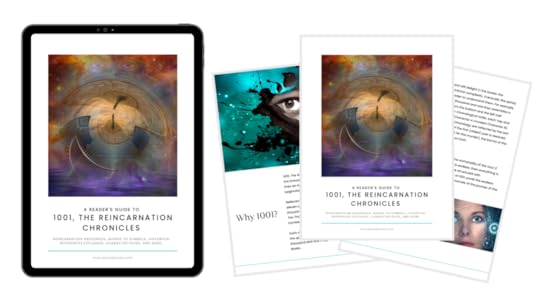
Join the mailing list for access to this invaluable resource and stay informed about future releases.
Ready to Begin Your Journey?Get your copy of The Qaraq, Book One of The Reincarnation Chronicles on October 1st, and immerse yourself in the rich, captivating world of reincarnation, past lives, and interwoven destinies.
If you’re new to it all, check out the rest of this website for lots of information about the whole series and yours truly, the author.
If you’re intrigued, join the mailing list and get a free introductory Reader’s Guide to the 1001 series. It’s a complex journey so the Guide is an invaluable resource to navigate the many Worlds.
Then participate in the launch and get a copy of The Qaraq, Book One of The Reincarnation Chronicles. And enjoy!
The post Relaunching 1001, The Reincarnation Chronicles on 10/01/2024 appeared first on Qaraq Books.
July 15, 2024
Picchu Keanu!
Just returned from a dazzling trip to Peru, Lake Titicaca, and Macchu Picchu. Here’s a few excerpts from my travel journal:
“After years of waiting, I finally visit Macchu Picchu, the Old Mountain. First of all, the train and bus ride to the summit alone are worth the trip. The round-top peaks lining the sacred Inca valley, the spring greens, and the mists are so beautiful that an ancient ruin isn’t necessary.”
“Our guide is native Quechuan, and is the mellowest human being I have ever met. But he speaks about the place, not with the ambiguous uncertainty of the theorists, who are unsure if Macchu Picchu was a shrine, a trading center, or a noble’s country home, but with a pride and surety that the city was all of these things and more. It feels like he is a descendant of the people living here centuries ago.”
“I had never imagined the ruin to be so intact, so comprehensive, and so huge. The only thing missing seems to be the thatch on the roofs, and the objects inside rooms, which now lie in museums.”
“The city is so well preserved because of the Inca stonework. Every stone fits perfectly with the others, and since they did not use mortar, during earthquakes the stones bobble around then fall back into place. Spanish walls at the same times crack or fall apart.”
“Tourists are not allowed to walk on the huge open green central square of the city. But llamas freely graze there, earning their food as the urban greenskeepers, camelid lawnmowers. I do not learn the difference between a llama, alpaca, and vicuna on this trip, but I do enjoy an alpaca hamburger.”
“In the Floating Islands of the Uros people in Lake Titicaca, everything is made of reeds, including their homes, the ground they stand on in these man-made islands, and the food they eat. A truly remote place, with its unique way of choosing to live.”
That’s a taste of my wonderful journey. Enjoy more tastes if you subscribe to The Maqaraqan.



